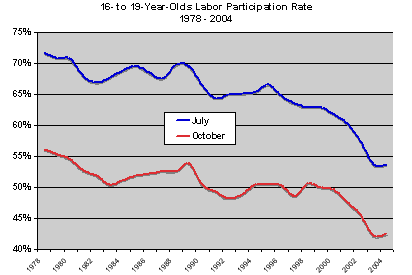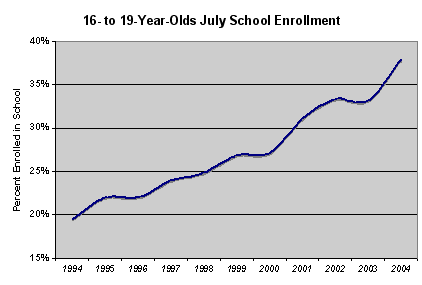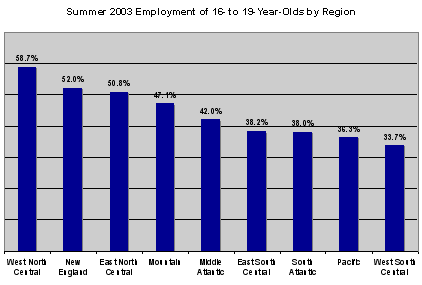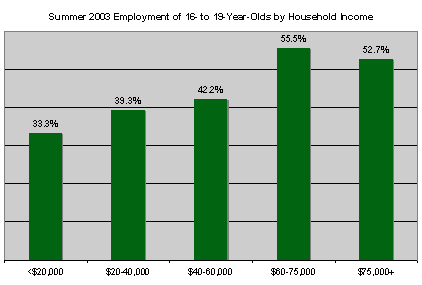Vol. V, No. 5, June 2005
- Editor's Corner
- Favorite foods: why ice cream rates high
- Foundations Entertainment University: July 19-21
- National Restaurant Association Show draws 70,000+
- The perils of selection bias in LBE development
- Fast-feeders raise the bar on coffee
- Where have the teenage workers gone?
- Waterpark resorts rapidly expanding
- Seconds count when serving that cup of Joe
- Our company's unique structure
- Death, taxes and Chuck E. Cheese's, aka the House of Terror
- uWink Media Bistro - a Chuck E. Cheese's for adults
- Chuck E. Cheese's $30-million remodel
- Allergy-free cooking for kids
- Current projects
Where have the teenage workers gone?
Most location-based leisure (LBL) facilities are dependent upon teenagers for a substantial portion of their labor force. Teenagers are especially important for the staffing of seasonal outdoor entertainment facilities that have their peak season in the summer, when most teenagers are on school summer vacation. These seasonal facilities include outdoor family fun centers, waterparks, amusement parks and agritainment facilities.
Recently, many LBLs are finding it increasing difficult to attract teenagers to fill jobs. So we decided to dig into the U.S. Census Bureau's and U.S. Department of Labor's statistics to see if we could find out exactly what is happening. We were surprised to find the reason was that fewer and fewer teenagers are entering the labor force, both during the school year and in the summer.
We took a look at the labor force participation rates for 16- to 19-year-olds in July, when they are on summer vacation, and in October, when school is in session (October traditionally has the highest job participation rate during the school year). Between 1978 and 2004, teenagers' labor participation rate in July has dropped by 25%, from 71.8% in 1978 to only 53.6% last July. Likewise, during October, their labor participation rate has dropped by one-quarter from 56.2% to 42.5%.

What this means is that in 2004 there were 3.3 million fewer 16- to 19-year-olds in the labor force than during July 1980. In fact, the number has declined from almost 12 million summer teenage workers in 1980 to less than 9 million in 2004. During the school year, the number has declined by 2.3 million.
| 16- to 19-Years-Old Labor Participation in July | ||||
|---|---|---|---|---|
| 1980 | 1990 | 2000 | 2004 | |
| Population 16-19 Years | 16,930,000 | 14,430,000 | 16,200,000 | 16,180,000 |
| Participation Rate | 70.7% | 66.5% | 61.8% | 53.6% |
| Number in Labor Force | 11,970,000 | 9,600,000 | 10,010,000 | 8,670,000 |
| 16- to 19-Years-Old Labor Participation in October | ||||
|---|---|---|---|---|
| 1980 | 1990 | 2000 | 2004 | |
| Population 16-19 Years | 16,930,000 | 14,430,000 | 16,200,000 | 16,180,000 |
| Participation Rate | 54.5% | 50.4% | 49.6% | 42.5% |
| Number in Labor Force | 9,220,000 | 7,270,000 | 8,030,000 | 6,870,000 |
That's a 28% decrease in the number of 16- to 19-year-olds working during the summer and a 25% decrease in the number working during the school year. Yet at the same time, the overall population of the U.S. has increased 35%, as has the number of jobs.
So what is happening? Why are teenagers working less, especially during the summer? Many demographers believe the explanation is that more youth are attending summer school for not only remediation, but also to stay competitive with fellow college-bound students. Some take short-term intensive classes or review courses for college admissions exams. Other high school students take a course during the summer so they don't have to take it in the fall, giving them the option during the school year of taking an elective or a higher-level course in the subject they studied in summer school.

The summer school enrollment rate for teenagers has almost quadrupled in the last two decades, from 10% in July 1984 to 19% in 1994 to 38% in July 2004. It appears that teens are now placing a higher emphasis on school rather than work during the summer.
Pressure to achieve -- at school, in sports and in other activities -- is the primary theory to explain why fewer 16- to19-year-olds have jobs during the school year. Teens are studying more, taking heavier course loads and are more involved in extracurricular activities.
Teenage participation in the workforce varies greatly by regions of the country. Teenagers in New England and the North Central region take summer jobs far more than teenagers in the Pacific and southern regions.

Perhaps our most surprising finding is that teenagers from families with higher incomes proportionally take more jobs than those from lower income families. This is just the opposite of what you would expect. But if you think about it, teenagers from lower income families usually live in areas where there are less job opportunities. They are also less likely to have their own cars they can use to drive to areas where jobs are available.

What this means is that LBEs will need to turn to other pools of workers
to meet their staffing needs. Many are looking at seniors. Our company
is advocating to our LBE developer clients that they develop centers that
will not be so seasonal, allowing them to hire more full-time and full-time
part-time workers to fill their needs.
Vol. V, No. 5, June 2005
- Editor's Corner
- Favorite foods: why ice cream rates high
- Foundations Entertainment University: July 19-21
- National Restaurant Association Show draws 70,000+
- The perils of selection bias in LBE development
- Fast-feeders raise the bar on coffee
- Where have the teenage workers gone?
- Waterpark resorts rapidly expanding
- Seconds count when serving that cup of Joe
- Our company's unique structure
- Death, taxes and Chuck E. Cheese's, aka the House of Terror
- uWink Media Bistro - a Chuck E. Cheese's for adults
- Chuck E. Cheese's $30-million remodel
- Allergy-free cooking for kids
- Current projects


